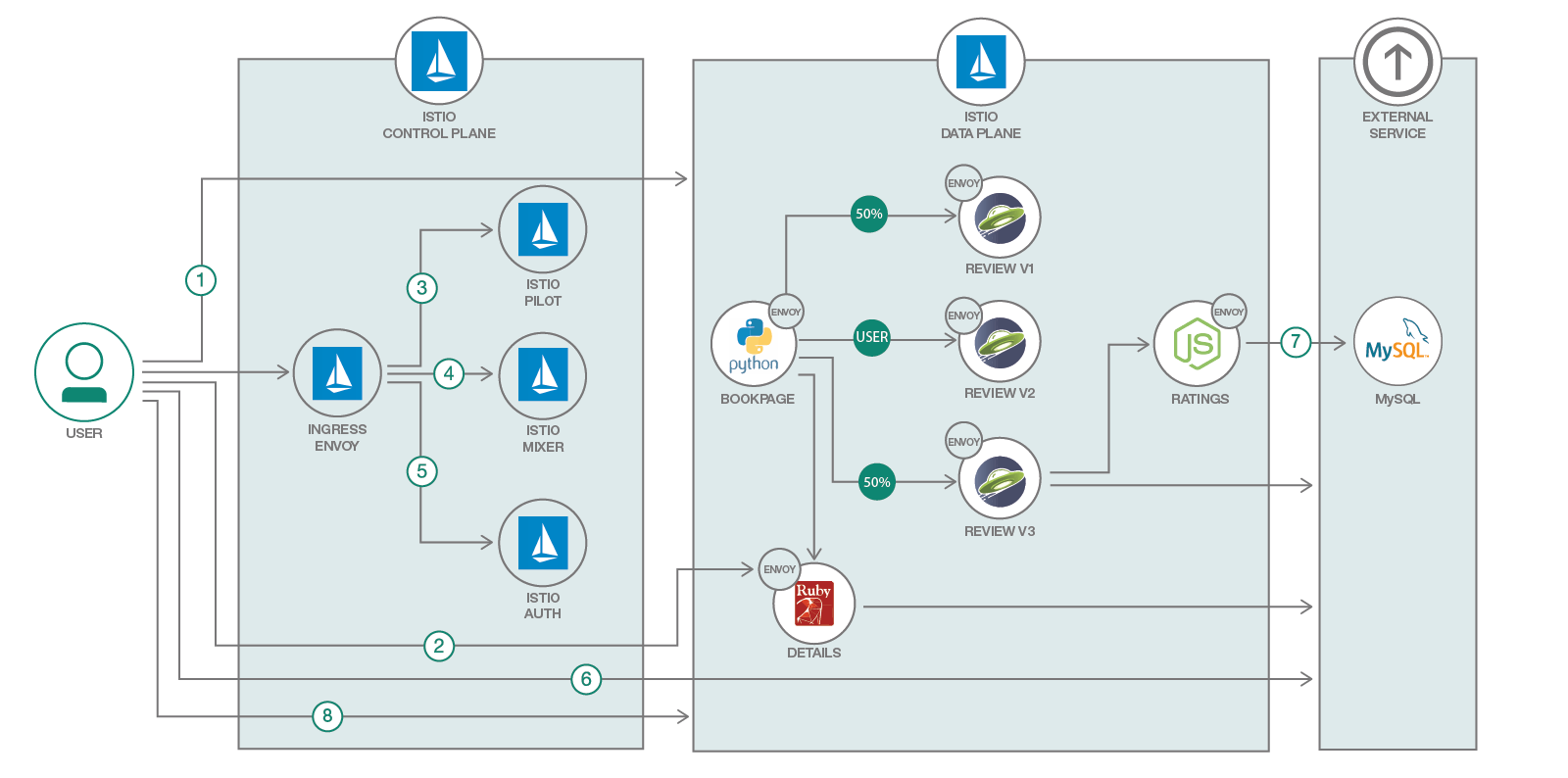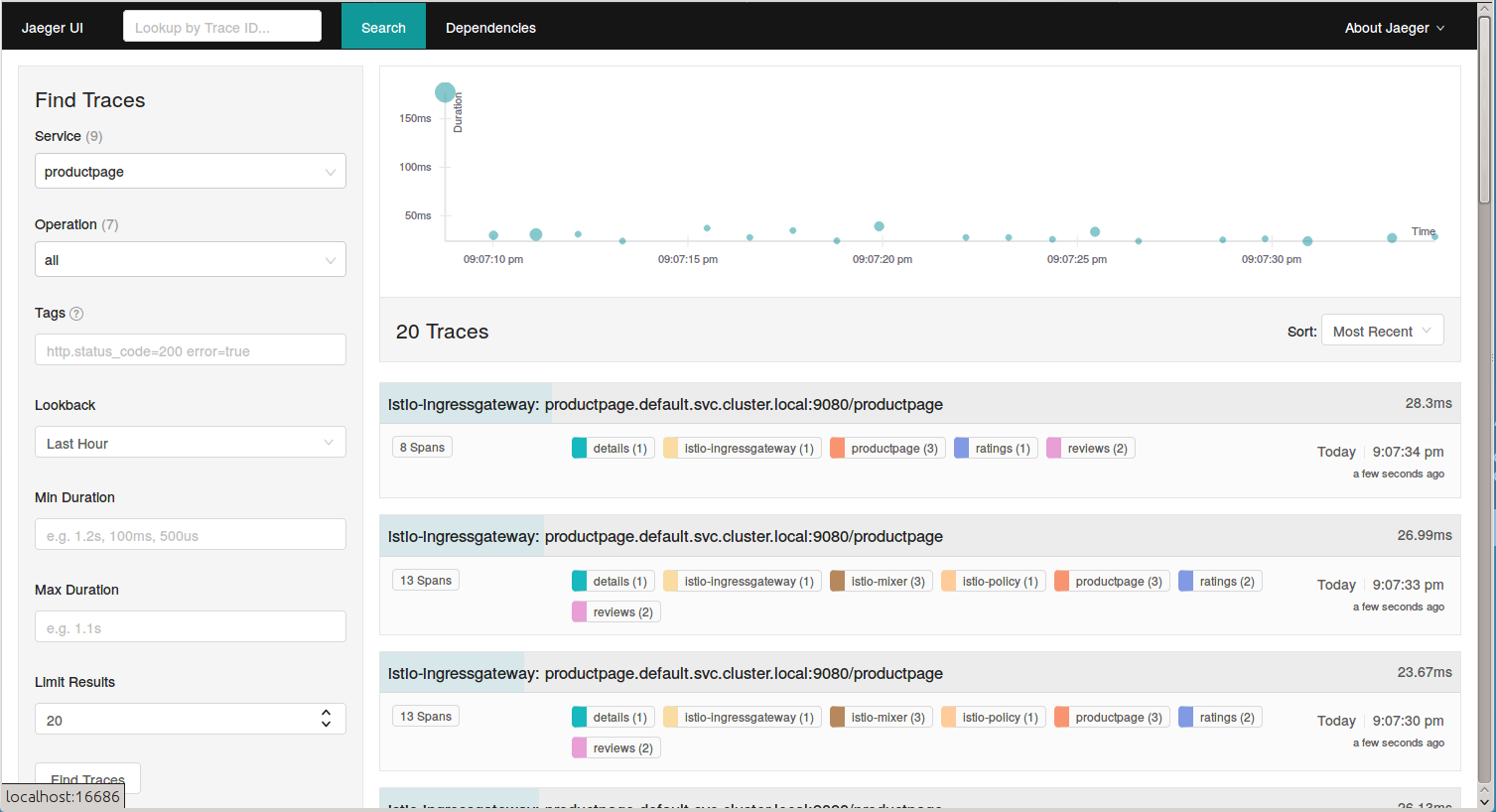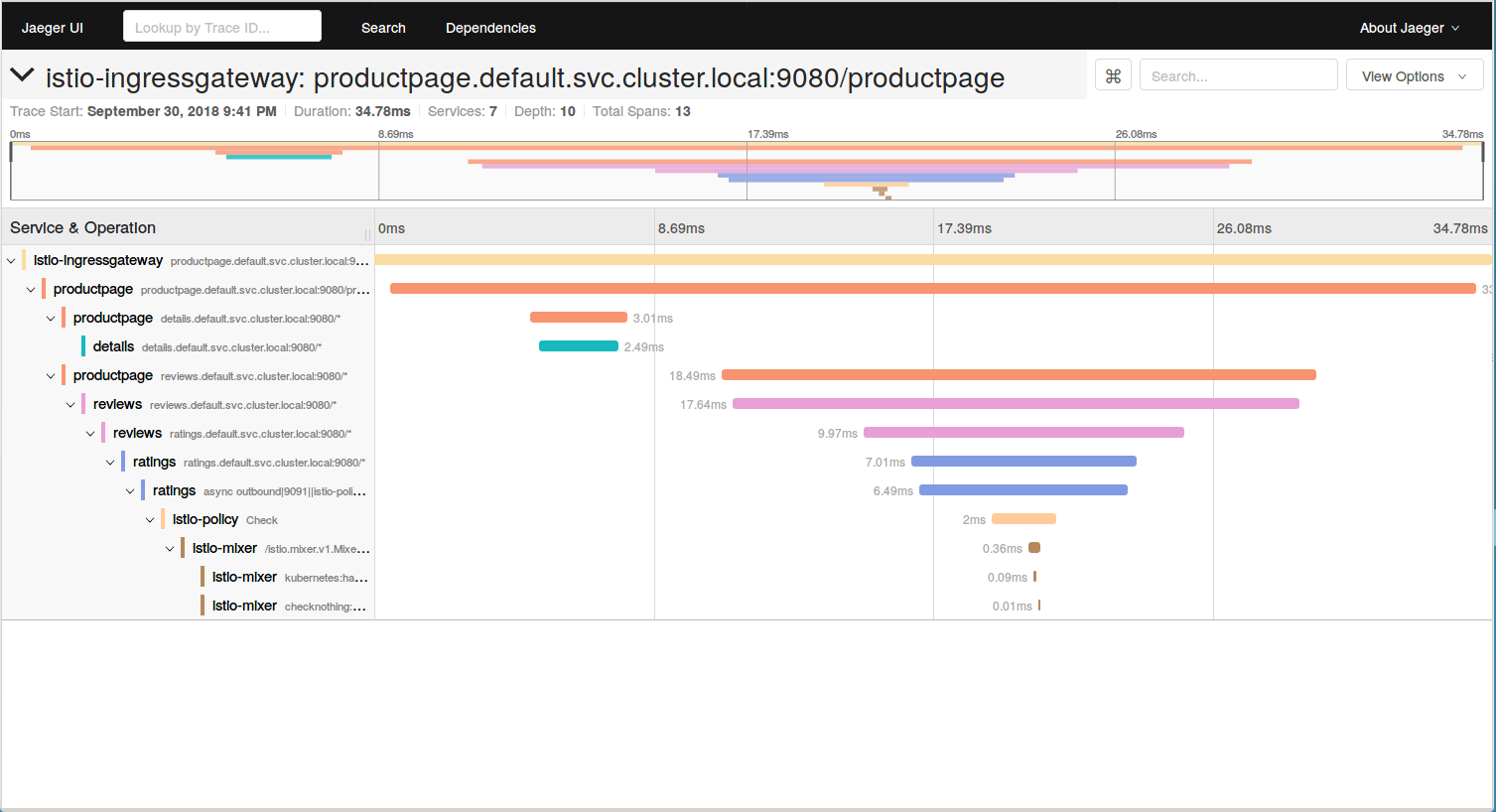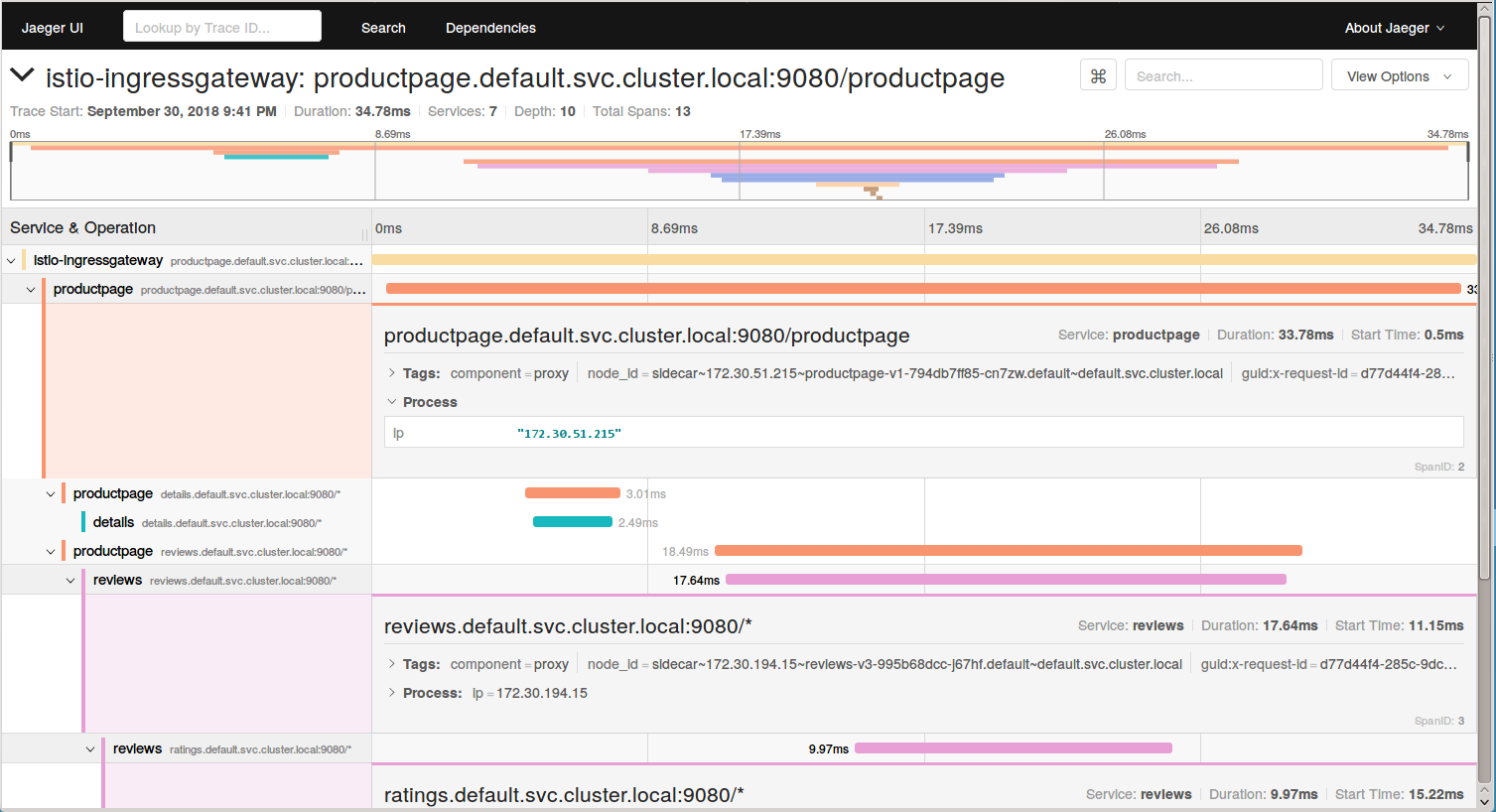IBM / Microservices Traffic Management Using Istio
Programming Languages
Projects that are alternatives of or similar to Microservices Traffic Management Using Istio
Istio: Traffic Management for your Microservices
Read this in other languages: 한국어.
Microservices and containers changed application design and deployment patterns, but along with them brought challenges like service discovery, routing, failure handling, and visibility to microservices. "Service mesh" architecture was born to handle these features. Applications are getting decoupled internally as microservices, and the responsibility of maintaining coupling between these microservices is passed to the service mesh.
Istio, a joint collaboration between IBM, Google and Lyft provides an easy way to create a service mesh that will manage many of these complex tasks automatically, without the need to modify the microservices themselves. Istio does this by:
-
Deploying a control plane that manages the overall network infrastructure and enforces the policy and traffic rules defined by the devops team
-
Deploying a data plane which includes “sidecars”, secondary containers that sit along side of each instance of a microservice and act as a proxy to intercept all incoming and outgoing network traffic. Sidecars are implemented using Envoy, an open source edge proxy
Once Istio is installed some of the key feature which it makes available include
-
Traffic management using Istio Pilot: In addition to providing content and policy based load balancing and routing, Pilot also maintains a canonical representation of services in the mesh.
-
Access control using Istio Auth: Istio Auth secures the service-to-service communication and also provides a key management system to manage keys and certificates.
-
Monitoring, reporting and quota management using Istio Mixer: Istio Mixer provides in depth monitoring and logs data collection for microservices, as well as collection of request traces. Precondition checking like whether the service consumer is on an allowlist, quota management like rate limits etc. are also configured using Mixer.
In the first part of this journey we show how we can deploy the sample BookInfo application and inject sidecars to get the Istio features mentioned above, and walk through the key ones. The BookInfo is a simple application that is composed of four microservices, written in different languages for each of its microservices namely Python, Java, Ruby, and Node.js. The application does not use a database, and stores everything in local filesystem.
Also since Istio tightly controls traffic routing to provide above mentioned benefits, it introduces some drawbacks. Outgoing traffic to external services outside the Istio data plane can only be enabled by specialized configuration, based on the protocol used to connect to the external service.
In the second part of the journey we focus on how Istio can be configured to allow applications to connect to external services. For that we modify the sample BookInfo application to use an external database and then use it as a base to show Istio configuration for enabling egress traffic.
Included Components
Prerequisite
Create a Kubernetes cluster with either Minikube for local testing, with IBM Cloud Private, or with IBM Cloud Kubernetes Service to deploy in cloud. The code here is regularly tested against IBM Cloud Kubernetes Service using Travis.
Create a working directory to clone this repo and to download Istio into:
$ mkdir ibm
$ cd ibm
$ git clone https://github.com/IBM/traffic-management-for-your-microservices-using-istio.git demo
You will also need Istio service mesh installed on top of your Kubernetes cluster. Here are the steps (Make sure to change the version to your downloaded one):
$ curl -L https://git.io/getLatestIstio | sh -
$ mv istio-<version> istio # replace with version downloaded
$ export PATH=$PWD/istio/bin:$PATH
$ kubectl apply -f istio/install/kubernetes/istio-demo.yaml
Steps
Part A: Deploy sample Bookinfo application and inject Istio sidecars to enable traffic flow management, access policy and monitoring data aggregation for application
- Deploy sample BookInfo application with Istio sidecar injected
- Configure Traffic flow
- Configure access control
- Collect metrics, logs and trace spans
Part B: Modify sample application to use an external datasource, deploy the application and Istio envoys with egress traffic enabled
- Create an external datasource for the application
- Modify sample application to use the external database
- Deploy application microservices and Istio envoys with egress traffic enabled
Part A: Deploy sample Bookinfo application and inject Istio sidecars to enable traffic flow management, access policy and monitoring data aggregation for application
1. Deploy sample BookInfo application with Istio sidecar injected
In this part, we will be using the sample BookInfo Application that comes as default with Istio code base. As mentioned above, the application that is composed of four microservices, written in different languages for each of its microservices namely Python, Java, Ruby, and Node.js. The default application doesn't use a database and all the microservices store their data in the local file system. Envoys are deployed as sidecars on each microservice. Injecting Envoy into your microservice means that the Envoy sidecar would manage the ingoing and outgoing calls for the service. To inject an Envoy sidecar to an existing microservice configuration, do:
$ kubectl apply -f <(istioctl kube-inject -f istio/samples/bookinfo/platform/kube/bookinfo.yaml)
istioctl kube-injectmodifies the yaml file passed in -f. This injects Envoy sidecar into your Kubernetes resource configuration. The only resources updated are Job, DaemonSet, ReplicaSet, and Deployment. Other resources in the YAML file configuration will be left unmodified.
After a few minutes, you should now have your Kubernetes Pods running and have an Envoy sidecar in each of them alongside the microservice. The microservices are productpage, details, ratings, and reviews. Note that you'll have three versions of the reviews microservice.
$ kubectl get pods
NAME READY STATUS RESTARTS AGE
details-v1-1520924117-48z17 2/2 Running 0 6m
productpage-v1-560495357-jk1lz 2/2 Running 0 6m
ratings-v1-734492171-rnr5l 2/2 Running 0 6m
reviews-v1-874083890-f0qf0 2/2 Running 0 6m
reviews-v2-1343845940-b34q5 2/2 Running 0 6m
reviews-v3-1813607990-8ch52 2/2 Running 0 6m
Create an Istio ingress gateway to access your services over a public IP address.
kubectl apply -f istio/samples/bookinfo/networking/bookinfo-gateway.yaml
To access your application, you can check the public IP address of your application with the following command. Replace "istio-book" below with the name of your Kubernetes cluster! Note the IP address will also be different for your cluster.
$ export GATEWAY_URL=$(ibmcloud ks workers istio-book | grep normal | awk '{print $2}' | head -1):$(kubectl get svc istio-ingressgateway -n istio-system -o jsonpath={.spec.ports[0].nodePort})
$ echo $GATEWAY_URL
169.55.105.75:31380
Now you can access your application via:http://${GATEWAY_URL}/productpage
If you refresh the page multiple times, you'll see that the reviews section of the page changes. That's because there are 3 versions of reviews(reviews-v1, reviews-v2, reviews-v3) deployment for our reviews service. Istio’s load-balancer is using a round-robin algorithm to iterate through the 3 instances of this service
2. Traffic flow management using Istio Pilot - Modify service routes
In this section, Istio will be configured to dynamically modify the network traffic between some of the components of our application. In this case we have 2 versions of the “reviews” component (v1 and v2) but we don’t want to replace review-v1 with review-v2 immediately. In most cases, when components are upgraded it’s useful to deploy the new version but only have a small subset of network traffic routed to it so that it can be tested before the old version is removed. This is often referred to as “canary testing”.
There are multiple ways in which we can control this routing. It can be based on which user or type of device that is accessing it, or a certain percentage of the traffic can be configured to flow to one version.
This step shows you how to configure where you want your service requests to go based on weights and HTTP Headers. You would need to be in the root directory of the Istio release you have downloaded on the Prerequisites section.
- Destination Rules
Before moving on, we have to define the destination rules. The destination rules tell Istio what versions (subsets in Istio terminology) are available for routing. This step is required before fine-grained traffic shaping is possible.
$ kubectl apply -f samples/bookinfo/networking/destination-rule-all.yaml
destinationrule.networking.istio.io/productpage created
destinationrule.networking.istio.io/reviews created
destinationrule.networking.istio.io/ratings created
destinationrule.networking.istio.io/details created
For more details, see the Istio documentation.
- Set Default Routes to
reviews-v1for all microservices
This would set all incoming routes on the services (indicated in the line destination: <service>) to the deployment with a tag version: v1. To set the default routes, run:
$ kubectl apply -f samples/bookinfo/networking/virtual-service-all-v1.yaml
- Set Route to
reviews-v2of reviews microservice for a specific user
This would set the route for the user jason (You can login as jason with any password in your deploy web application) to see the version: v2 of the reviews microservice. Run:
$ kubectl apply -f samples/bookinfo/networking/virtual-service-reviews-test-v2.yaml
- Route 50% of traffic on reviews microservice to
reviews-v1and 50% toreviews-v3.
This is indicated by the weight: 50 in the yaml file.
Using
replaceshould allow you to edit existing route-rules.
$ kubectl apply -f samples/bookinfo/networking/virtual-service-reviews-50-v3.yaml
- Route 100% of the traffic to the
version: v3of the reviews microservices
This will direct all incoming traffic to version v3 of the reviews microservice. Run:
$ kubectl apply -f samples/bookinfo/networking/virtual-service-reviews-v3.yaml
3. Access policy enforcement using Istio Mixer - Configure access control
This step shows you how to control access to your services. It helps to reset the routing rules to ensure that we are starting with a known configuration. The following commands will first set all review requests to v1, and then apply a rule to route requests from user jason to v2, while all others go to v3:
kubectl apply -f samples/bookinfo/networking/virtual-service-all-v1.yaml
kubectl apply -f samples/bookinfo/networking/virtual-service-reviews-jason-v2-v3.yaml
You'll now see that your productpage always red stars on the reviews section if not logged in, and always shows black stars when logged in as jason.
-
To deny access to the ratings service for all traffic coming from
reviews-v3, you will use apply these rules:kubectl apply -f samples/bookinfo/policy/mixer-rule-deny-label.yaml kubectl apply -f samples/bookinfo/policy/mixer-rule-ratings-denial.yaml
-
To verify if your rule has been enforced, point your browser to your BookInfo Applicatio. You'll notice you see no stars from the reviews section unless you are logged in as jason, in which case you'll see black stars.
4. Telemetry data aggregation using Istio Mixer - Collect metrics, logs and trace spans
4.1 Collect metrics and logs using Prometheus and Grafana
This step shows you how to configure Istio Mixer to gather telemetry for services in your cluster.
-
Verify that the required Istio addons (Prometheus and Grafana) are available in your cluster:
$ kubectl get pods -n istio-system | grep -E 'prometheus|grafana' grafana-6cbdcfb45-bwmtm 1/1 Running 0 4d istio-grafana-post-install-h2dgz 0/1 Completed 1 4d prometheus-84bd4b9796-vnb58 1/1 Running 0 4d
-
Verify that your Grafana dashboard is ready. Get the IP of your cluster
bx cs workers <your-cluster-name>and then the NodePort of your Grafana servicekubectl get svc | grep grafanaor you can run the following command to output both:$ kubectl -n istio-system port-forward $(kubectl -n istio-system get pod -l app=grafana \ -o jsonpath='{.items[0].metadata.name}') 3000:3000
Point your browser to http://localhost:3000
-
To collect new telemetry data, you will apply a mixer rule. For this sample, you will generate logs for Response Size for Reviews service. The configuration YAML file is provided within the BookInfo sample folder.
-
Create the configuration on Istio Mixer using the configuration in new-metrics-rule.yaml `
$ kubectl apply -f new-metrics-rule.yaml metric.config.istio.io/doublerequestcount created prometheus.config.istio.io/doublehandler created rule.config.istio.io/doubleprom created logentry.config.istio.io/newlog created stdio.config.istio.io/newhandler created rule.config.istio.io/newlogstdio created metric.config.istio.io/doublerequestcount unchanged prometheus.config.istio.io/doublehandler unchanged rule.config.istio.io/doubleprom unchanged logentry.config.istio.io/newlog unchanged stdio.config.istio.io/newhandler unchanged rule.config.istio.io/newlogstdio unchanged
-
Send traffic to that service by refreshing your browser to
http://${GATEWAY_URL}/productpagemultiple times. Alternately, thewatchcommand allows you to easily call the productpage URL and watch the activity in the Grafana dashboard:$ watch -n 1 curl -s http://${GATEWAY_URL}/productpage
-
Verify that the new metric is being collected by going to your Grafana dashboard again. The graph on the rightmost should now be populated.
-
Verify that the logs stream has been created and is being populated for requests
$ kubectl -n istio-system logs $(kubectl -n istio-system get pods -l istio=mixer -o jsonpath='{.items[0].metadata.name}') mixer | grep \"instance\":\"newlog.logentry.istio-system\" {"level":"warn","ts":"2017-09-21T04:33:31.249Z","instance":"newlog.logentry.istio-system","destination":"details","latency":"6.848ms","responseCode":200,"responseSize":178,"source":"productpage","user":"unknown"} ...
Collecting Metrics and Logs on Istio
4.2 Collect request traces using Jaeger
Jaeger is a distributed tracing tool that is available with Istio.
-
Access your Jaeger Dashboard by setting up port forwarding to the Jaeger pod with this command:
$ kubectl port-forward -n istio-system $(kubectl get pod -n istio-system -l app=jaeger -o jsonpath='{.items[0].metadata.name}') 16686:16686
Access the Jaeger dashboard
http://localhost:16686 -
Send traffic to that service by refreshing your browser to
http://${GATEWAY_URL}/productpagemultiple times. You can also do reuse thewatchcommand from earlier. -
Go to your Jeger Dashboard again and you will see a number of traces done. _Click on Find Traces button to see the recent traces (previous hour by default.)
- Click on one of those traces and you will see the details of the traffic you sent to your BookInfo App. It shows how much time it took for the request on
productpageto finish. It also shows how much time it took for the requests on thedetails,reviews, andratingsservices.
Part B: Modify sample application to use an external datasource, deploy the application and Istio envoys with egress traffic enabled
In this part, we will modify the sample BookInfo application to use use an external database, and enable egress traffic. Please ensure you have the Istio control plane installed on your Kubernetes cluster as mentioned in the prerequisites.
5. Create an external datasource for the application
Provision Compose for MySQL in IBM Cloud via https://console.ng.bluemix.net/catalog/services/compose-for-mysql
Go to Service credentials and view your credentials. Your MySQL hostname, port, user, and password are under your credential uri and it should look like this

6. Modify sample application to use the external database
In this step, the original sample BookInfo Application is modified to leverage a MySQL database. The modified microservices are the details, ratings, and reviews. This is done to show how Istio can be configured to enable egress traffic for applications leveraging external services outside the Istio data plane, in this case a database.
In this step, you can either choose to build your Docker images for different microservices from source in the microservices folder or use the given images.
For building your own images, go to microservices folder
The following modifications were made to the original Bookinfo application. The details microservice is using Ruby and a mysql ruby gem was added to connect to a MySQL database. The ratings microservice is using Node.js and a mysql module was added to connect to a MySQL database. The reviews v1,v2,v3 microservices is using Java and a mysql-connector-java dependency was added in build.gradle to connect to a MySQL database. The reviews
service runs inside an OpenLiberty container running on OpenJ9. More source code was added to details.rb, ratings.js, LibertyRestEndpoint.java that enables the application to use the details, ratings, and reviews data from the MySQL Database.
Preview of added source code for ratings.js for connecting to MySQL database:
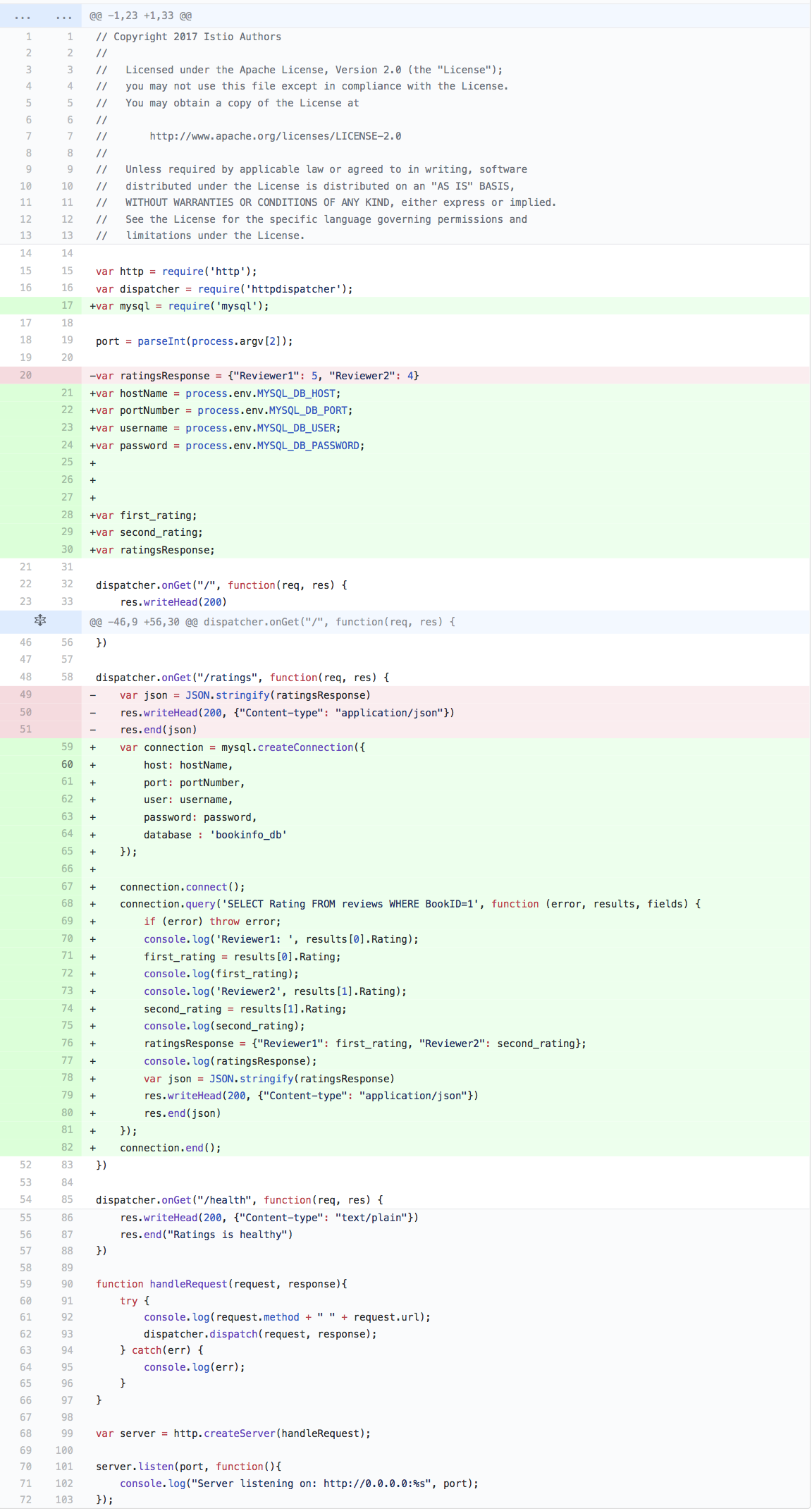
You will need to update the secrets.yaml file to include the credentials provided by IBM Cloud Compose.
Note: The values provided in the secrets file should be run through
base64first.
echo -n <username> | base64
echo -n <password> | base64
echo -n <host> | base64
echo -n <port> | base64
apiVersion: v1
kind: Secret
metadata:
name: demo-credentials
type: Opaque
data:
username: YWRtaW4=
password: VEhYTktMUFFTWE9BQ1JPRA==
host: c2wtdXMtc291dGgtMS1wb3J0YWwuMy5kYmxheWVyLmNvbQ==
port: MTg0ODE=
Once the secrets are set add them to your Kubernetes cluster:
$ kubectl apply -f secrets.yaml
You can verify the values of the keys in the secrets object for the mysql database with:
$ kubectl get secret demo-credentials -o json | grep -A4 '"data"'
"data": {
"host": "c2wtdXMtc291dGgtMS1wb3J0YWwuMzguZGJsYXllci5jb20=",
"password": "T0NVUUhDQ1NKT0JEVEtUWQ==",
"port": "NTk0NTQ=",
"username": "YWRtaW4="
7. Deploy application microservices and Istio envoys with Egress traffic enabled
By default, Istio-enabled applications will be unable to access URLs outside of the cluster. All outbound traffic in the pod are redirected by its sidecar proxy which only handles destinations inside the cluster.
Istio allows you to define a ServiceEntry to control egress to external services. We've defined a simple egress configuration using a ServiceEntry to allow services to talk to the MySQL Compose instance. In the MySQL-egress.yaml file, change the host and number fields to the hostname and port provided in the Compose connection string, and then use kubectl to apply the changes.
apiVersion: networking.istio.io/v1alpha3
kind: ServiceEntry
metadata:
name: MySQL-cloud
spec:
hosts:
- sl-us-south-1-portal.38.dblayer.com
ports:
- number: 59454
protocol: tcp
location: MESH_EXTERNAL
$ kubectl apply -f mysql-egress.yaml
- Insert data in your MySQL database in IBM Cloud.
This inserts the database design and initial data for the database.
$ kubectl apply -f mysql-data.yaml
As an initial step, remove the ingress rules from the sample app, as they are not compatible with the MySQL demo portion:
kubectl delete -f istio/samples/bookinfo/networking/bookinfo-gateway.yaml
- Deploy
productpagewith Envoy injection and thegatewayfor products and reviews.
$ kubectl apply -f <(istioctl kube-inject -f bookinfo.yaml)
$ kubectl apply -f bookinfo-gateway.yaml
- Deploy
detailswith Envoy injection and Egress traffic enabled.
$ kubectl apply -f <(istioctl kube-inject -f details-new.yaml)
Note that Kubernetes apply shuts down the old pod and replaces it with the new one.
$ kubectl get pods
NAME READY STATUS RESTARTS AGE
details-v1-76df85799c-njdk7 2/2 Terminating 0 5d
details-v1-86f56ff4d8-cc9fr 0/2 PodInitializing 0 7s
productpage-v1-5c67c7d4d7-4mkjm 2/2 Running 0 2m
ratings-v1-648467b449-4f7kp 2/2 Running 0 5d
reviews-v1-76ff8854fc-n5b6l 2/2 Running 0 5d
reviews-v2-65cb86568c-nqhqk 2/2 Running 0 5d
reviews-v3-995b68dcc-j67hf 2/2 Running 0 5d
setup 0/1 Completed 0 3m
- Deploy
reviewswith Envoy injection and Egress traffic enabled.
$ kubectl apply -f <(istioctl kube-inject -f reviews-new.yaml)
- Deploy
ratingswith Envoy injection and Egress traffic enabled.
$ kubectl apply -f <(istioctl kube-inject -f ratings-new.yaml)
You can now access your application to confirm that it is getting data from your MySQL database.
Point your browser to:
http://${GATEWAY_URL}/productpage
Troubleshooting
- To delete Istio from your cluster
$ kubectl delete -f istio/install/kubernetes/istio-demo.yaml
- To delete the BookInfo app and its route-rules:
./samples/bookinfo/platform/kube/cleanup.sh
References
License
This code pattern is licensed under the Apache Software License, Version 2. Separate third party code objects invoked within this code pattern are licensed by their respective providers pursuant to their own separate licenses. Contributions are subject to the Developer Certificate of Origin, Version 1.1 (DCO) and the Apache Software License, Version 2.

